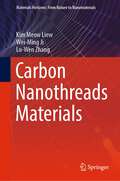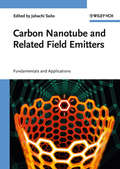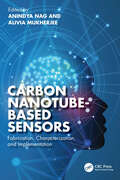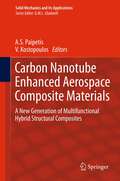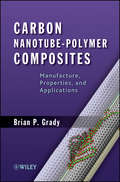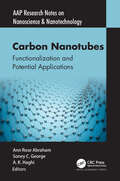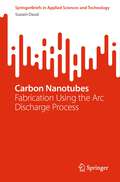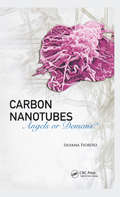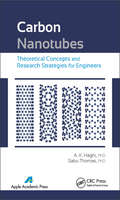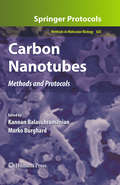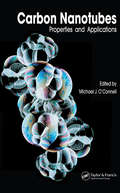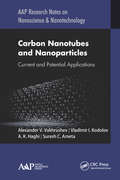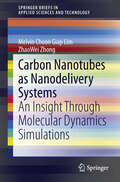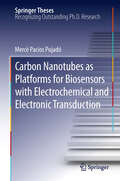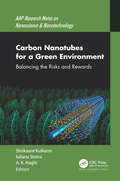- Table View
- List View
Carbon Nanothreads Materials (Materials Horizons: From Nature to Nanomaterials)
by Kim Meow Liew Wei-Ming Ji Lu-Wen ZhangThis book describes carbon nanothreads with complete and comprehensive knowledge covering theories, numerical methods, and properties comparisons with other carbon-based nanomaterials. For one thing, the main theoretical aspects in this book include: First-Principle Calculation, Density Functional Theory, Classical Molecular Dynamics Simulation, Non-equilibrium Molecular Dynamics Simulation, and Coarse Grained Simulation. For another thing, the main research contents include: Fundamental Mechanical Properties; Fracture Characteristics; Electronic and Magnetic Properties; Thermal Properties; Reinforcement in Polymer Composites; and other promising applications in engineering. The target of this book is to provide to many researchers the available theoretical and numerical methods, and useful computational results of carbon nanothreads for reference. This book can be used as a comprehensive source for scientists, academics, researchers, and engineers in various areas of engineering, physical sciences, and computational modeling. In order to achieve this target, the book introduces the microstructure information of carbon nanothreads and the modeling details at full length. The tunable mechanisms of physical properties of carbon nanothreads are discussed in detail, which enable integration of these nanoscale components into high-order structures for “bottom-up design” purpose. The revealed reinforced mechanisms of carbon nanothreads in polymer composites can provide theoretical guidance for engineering design of advanced polymer composites.
Carbon Nanotube and Related Field Emitters: Fundamentals and Applications
by Yahachi SaitoCarbon nanotubes (CNTs) have novel properties that make them potentially useful in many applications in nanotechnology, electronics, optics and other fields of materials science. These characteristics include extraordinary strength, unique electrical properties, and the fact that they are efficient heat conductors. Field emission is the emission of electrons from the surface of a condensed phase into another phase due to the presence of high electric fields. CNT field emitters are expected to make a breakthrough in the development of field emission display technology and enable miniature X-ray sources that will find a wide variety of applications in electronic devices, industry, and medical and security examinations. This first monograph on the topic covers all aspects in a concise yet comprehensive manner - from the fundamentals to applications. Divided into four sections, the first part discusses the preparation and characterization of carbon nanotubes, while part two is devoted to the field emission properties of carbon nanotubes, including the electron emission mechanism, characteristics of CNT electron sources, and dynamic behavior of CNTs during operation. Part three highlights field emission from other nanomaterials, such as carbon nanowalls, diamond, and silicon and zinc oxide nanowires, before concluding with frontier R&D applications of CNT emitters, from vacuum electronic devices such as field emission displays, to electron sources in electron microscopes, X-ray sources, and microwave amplifiers. Edited by a pioneer in the field, each chapter is written by recognized experts in the respective fields.
Carbon Nanotube and Related Field Emitters: Fundamentals and Applications
by Yahachi SaitoCarbon nanotubes (CNTs) have novel properties that make them potentially useful in many applications in nanotechnology, electronics, optics and other fields of materials science. These characteristics include extraordinary strength, unique electrical properties, and the fact that they are efficient heat conductors. Field emission is the emission of electrons from the surface of a condensed phase into another phase due to the presence of high electric fields. CNT field emitters are expected to make a breakthrough in the development of field emission display technology and enable miniature X-ray sources that will find a wide variety of applications in electronic devices, industry, and medical and security examinations. This first monograph on the topic covers all aspects in a concise yet comprehensive manner - from the fundamentals to applications. Divided into four sections, the first part discusses the preparation and characterization of carbon nanotubes, while part two is devoted to the field emission properties of carbon nanotubes, including the electron emission mechanism, characteristics of CNT electron sources, and dynamic behavior of CNTs during operation. Part three highlights field emission from other nanomaterials, such as carbon nanowalls, diamond, and silicon and zinc oxide nanowires, before concluding with frontier R&D applications of CNT emitters, from vacuum electronic devices such as field emission displays, to electron sources in electron microscopes, X-ray sources, and microwave amplifiers. Edited by a pioneer in the field, each chapter is written by recognized experts in the respective fields.
Carbon Nanotube-Based Sensors: Fabrication, Characterization, and Implementation
by Anindya Nag Alivia MukherjeeCarbon Nanotube-Based Sensors: Fabrication, Characterization, and Implementation highlights the latest research and developments on carbon nanotubes (CNTs) and their applications in sensors and sensing systems. It offers an overview of CNTs, including their synthesis, functionalization, characterization, and toxicology. It then delves into the fabrication and various applications of CNT-based sensors.FEATURES Defines the significance of different forms of CNT-based sensors synthesized for diverse engineering applications and compares the feasibility of their generation Helps readers evaluate different types of fabrication techniques to generate CNTs and their subsequent sensing Discusses fabrication of low-cost, efficient CNTs-based sensors that can be used for diverse applications and sheds light on synthesis methods for a range of printing techniques Highlights challenges and advances in security-related issues using CNTs-based sensors This book is aimed at researchers in the fields of materials and electrical engineering who are interested in the development of sensor technology for industrial, biomedical, and related applications.
Carbon Nanotube-Based Sensors: Fabrication, Characterization, and Implementation
Carbon Nanotube-Based Sensors: Fabrication, Characterization, and Implementation highlights the latest research and developments on carbon nanotubes (CNTs) and their applications in sensors and sensing systems. It offers an overview of CNTs, including their synthesis, functionalization, characterization, and toxicology. It then delves into the fabrication and various applications of CNT-based sensors.FEATURES Defines the significance of different forms of CNT-based sensors synthesized for diverse engineering applications and compares the feasibility of their generation Helps readers evaluate different types of fabrication techniques to generate CNTs and their subsequent sensing Discusses fabrication of low-cost, efficient CNTs-based sensors that can be used for diverse applications and sheds light on synthesis methods for a range of printing techniques Highlights challenges and advances in security-related issues using CNTs-based sensors This book is aimed at researchers in the fields of materials and electrical engineering who are interested in the development of sensor technology for industrial, biomedical, and related applications.
Carbon Nanotube Enhanced Aerospace Composite Materials: A New Generation of Multifunctional Hybrid Structural Composites (Solid Mechanics and Its Applications #188)
by A. S. Paipetis and V. KostopoulosThe well documented increase in the use of high performance composites as structural materials in aerospace components is continuously raising the demands in terms of dynamic performance, structural integrity, reliable life monitoring systems and adaptive actuating abilities. Current technologies address the above issues separately; material property tailoring and custom design practices aim to the enhancement of dynamic and damage tolerance characteristics, whereas life monitoring and actuation is performed with embedded sensors that may be detrimental to the structural integrity of the component. This publication explores the unique properties of carbon nanotubes (CNT) as an additive in the matrix of Fibre Reinforced Plastics (FRP), for producing structural composites with improved mechanical performance as well as sensing/actuating capabilities. The successful combination of the CNT properties and existing sensing actuating technologies leads to the realization of a multifunctional FRP structure. The current volume presents the state of the art research in this field. The contributions cover all the aspects of the novel composite systems, i.e. modeling from nano to macro scale, enhancement of structural efficiency, dispersion and manufacturing, integral health monitoring abilities, Raman monitoring, as well as the capabilities that ordered carbon nanotube arrays offer in terms of sensing and/or actuating in aerospace composites.
Carbon Nanotube-Polymer Composites: Manufacture, Properties, and Applications
by Brian P. GradyThe accessible compendium of polymers in carbon nanotubes (CNTs) Carbon nanotubes (CNTs)—extremely thin tubes only a few nanometers in diameter but able to attain lengths thousands of times greater—are prime candidates for use in the development of polymer composite materials. Bringing together thousands of disparate research works, Carbon Nanotube-Polymer Composites: Manufacture, Properties, and Applications covers CNT-polymers from synthesis to potential applications, presenting the basic science and engineering of this dynamic and complex area in an accessible, readable way. Designed to be of use to polymer scientists, engineers, chemists, physicists, and materials scientists, the book covers carbon nanotube fundamentals to help polymer experts understand CNTs, and polymer physics to help those in the CNT field, making it an invaluable resource for anyone working with CNT-polymer composites. Detailed chapters describe the mechanical, rheological, electrical, and thermal properties of carbon nanotube-polymer composites. Including a glossary that defines key terms, Carbon Nanotube-Polymer Composites is essential reading for anyone looking to gain a fundamental understanding of CNTs and polymers, as well as potential and current applications, including electronics (shielding and transparent electrodes), flame retardants, and electromechanics (sensors and actuators), and their challenges.
Carbon Nanotube-Polymer Composites: Manufacture, Properties, and Applications
by Brian P. GradyThe accessible compendium of polymers in carbon nanotubes (CNTs) Carbon nanotubes (CNTs)—extremely thin tubes only a few nanometers in diameter but able to attain lengths thousands of times greater—are prime candidates for use in the development of polymer composite materials. Bringing together thousands of disparate research works, Carbon Nanotube-Polymer Composites: Manufacture, Properties, and Applications covers CNT-polymers from synthesis to potential applications, presenting the basic science and engineering of this dynamic and complex area in an accessible, readable way. Designed to be of use to polymer scientists, engineers, chemists, physicists, and materials scientists, the book covers carbon nanotube fundamentals to help polymer experts understand CNTs, and polymer physics to help those in the CNT field, making it an invaluable resource for anyone working with CNT-polymer composites. Detailed chapters describe the mechanical, rheological, electrical, and thermal properties of carbon nanotube-polymer composites. Including a glossary that defines key terms, Carbon Nanotube-Polymer Composites is essential reading for anyone looking to gain a fundamental understanding of CNTs and polymers, as well as potential and current applications, including electronics (shielding and transparent electrodes), flame retardants, and electromechanics (sensors and actuators), and their challenges.
Carbon Nanotube-Polymer Nanocomposites: Synthesis, Properties, and Applications (Engineering Materials)
by Suresh Sagadevan Srikanta Moharana Lipeeka RoutThis book presents the latest advancements in various synthetic techniques, properties, characterization, and efficient applications of CNT-polymer nanocomposites. The preparation, properties, characterization, and applications of these technologically intriguing new materials are discussed in detail. The book covers a wide range of topics from the fundamentals of carbon nanotubes, their reinforced polymer nanocomposites and their applications in various fields including energy storage, 3D printing, electronics, aerospace and coatings, and environmental and bio-medical/bioengineering. It is a good resource for students, material scientists, and professionals interested in the synthesis, properties, characteristics, and cutting-edge applications of carbon nanotubes-polymer nanocomposites.
Carbon Nanotubes: Functionalization and Potential Applications (AAP Research Notes on Nanoscience and Nanotechnology)
by Ann Rose Abraham Soney C. George A. K. HaghiThis new book discusses a selection of advanced topics on carbon nanotubes—their extraordinary properties, structure, design, fabrication, development, engineering, functionalization, carbon nanotube enabled nanocomposites, characterization, and, moreover, their utility in many applications. The volume highlights the amazing potential of advanced CNT composites in automotive, aeronautics, spacecrafts, transistors replacing Si electronics, energy, purification, hydrogen storage, tissue regeneration, electrochemical supercapacitors, sensing, biomedical applications, agriculture, energy, and technical applications. The book specifically discusses the applications of carbon nanotubes for a greener environment, as well as applications for biomedical uses, in drug delivery, and in display technology. It also explores the uses of CNTs in the energy and aerospace industries, such as for solar energy conversion, as a lubricant additive for enhancing energy efficiency, and more. Other chapters explore the potential of carbon nanotubes in hydrogen storage and carbon nanotube electronics.
Carbon Nanotubes: Functionalization and Potential Applications (AAP Research Notes on Nanoscience and Nanotechnology)
by Ann Rose Abraham Soney C. George A. K. HaghiThis new book discusses a selection of advanced topics on carbon nanotubes—their extraordinary properties, structure, design, fabrication, development, engineering, functionalization, carbon nanotube enabled nanocomposites, characterization, and, moreover, their utility in many applications. The volume highlights the amazing potential of advanced CNT composites in automotive, aeronautics, spacecrafts, transistors replacing Si electronics, energy, purification, hydrogen storage, tissue regeneration, electrochemical supercapacitors, sensing, biomedical applications, agriculture, energy, and technical applications. The book specifically discusses the applications of carbon nanotubes for a greener environment, as well as applications for biomedical uses, in drug delivery, and in display technology. It also explores the uses of CNTs in the energy and aerospace industries, such as for solar energy conversion, as a lubricant additive for enhancing energy efficiency, and more. Other chapters explore the potential of carbon nanotubes in hydrogen storage and carbon nanotube electronics.
Carbon Nanotubes: Fabrication Using the Arc Discharge Process (SpringerBriefs in Applied Sciences and Technology)
by Suzairi DaudThis book highlights a comprehensive understanding of the fabrication and growth of carbon nanostructures via the arc discharge process. Its content is designed to benefit academicians, students, researchers, scientists, and readers who are interested in gaining knowledge in this area. The book presents findings on the arc discharge process and provide detailed information on the optimal state and energy of carbon ions in arc discharge plasma, observed under different pressures and ambient environments. The contents presented here can be applied to enhance the performance of various applications. This book provides a valuable resource for those looking to gain a deeper understanding of the arc discharge process and the growth of carbon nanostructures, with practical applications in industries such as electronics, semiconductors, and energy storage.
Carbon Nanotubes: Angels or Demons?
by Silvana FioritoThe field of C-nanoparticles toxicity is, at present, fragmented and contradictory, oscillating between enthusiastic raptures and bitter disappointments. This important book presents an overall, unitary view of the carbon nanoparticle world, in which both the positive and negative aspects of these recently discovered nanomaterials are critically de
Carbon Nanotubes: Angels or Demons?
by Silvana FioritoThe field of C-nanoparticles toxicity is, at present, fragmented and contradictory, oscillating between enthusiastic raptures and bitter disappointments. This important book presents an overall, unitary view of the carbon nanoparticle world, in which both the positive and negative aspects of these recently discovered nanomaterials are critically de
Carbon Nanotubes: Theoretical Concepts and Research Strategies for Engineers
by A. K. Haghi Sabu ThomasThis book presents the diversity of recent advances in carbon nanotubes from a broad perspective that will be useful for scientists as well as for graduate students and engineers. Presenting leading-edge research in this dynamic field, this volume is an introduction to the physical concepts needed for investigating carbon nanotubes and other one-di
Carbon Nanotubes: Advanced Topics in the Synthesis, Structure, Properties and Applications (Topics in Applied Physics #111)
by Ado Jorio Gene Dresselhaus Mildred S. DresselhausBuilding on the success of its predecessor, Carbon Nanotubes: Synthesis, Structure, Properties and Applications, this second volume focuses on those areas that have grown rapidly in the past few years. Contributing authors reflect the multidisciplinary nature of the book and are all leaders in their particular areas of research. Among the many topics they cover are graphene and other carbon-like and tube-like materials, which are likely to affect and influence developments in nanotubes within the next five years. Extensive use of illustrations enables you to better understand and visualize key concepts and processes.
Carbon Nanotubes: Methods and Protocols (Methods in Molecular Biology #625)
by Kannan Balasubramanian and Marko BurghardDue to their rare combination of high chemical stability, exceptional optical and electrical properties, high surface-to-volume ratio, and high aspect ratio, carbon nanotubes (CNTs) have made an enormous impact on materials science, molecular biology, biomedicine, and bioanalytical chemistry. Carbon Nanotubes: Methods and Protocols provides reliable, consistent protocols on the application of CNTs in molecular biology-related fields. These are of vital importance, as the commercially available CNTs differ in purity, agglomeration state, as well as length and diameter distribution, all of which have a profound influence on the dispersability and surface properties of the tubes. The volume contains detailed sections on functionalization, toxicity, trafficking, scaffolds, and biosensors, provided by expert researchers from various fields. Written in the highly successful Methods in Molecular Biology™ series format, chapters include introductions to their respective topics, lists of the necessary materials and reagents, step-by-step, readily reproducible laboratory protocols, and notes on troubleshooting and avoiding known pitfalls. Authoritative and cutting-edge, Carbon Nanotubes: Methods and Protocols serves to contribute to the achievement of common standards and helps researchers to avoid discrepancies in future biology-related CNT studies.
Carbon Nanotubes: Properties and Applications
by Michael J. O’ConnellSince their discovery more than a decade ago, carbon nanotubes (CNTs) have held scientists and engineers in captive fascination, seated on the verge of enormous breakthroughs in areas such as medicine, electronics, and materials science, to name but a few. Taking a broad look at CNTs and the tools used to study them, Carbon Nanotubes: Properties and Applications comprises the efforts of leading nanotube researchers led by Michael O’Connell, protégé of the late father of nanotechnology, Richard Smalley. Each chapter is a self-contained treatise on various aspects of CNT synthesis, characterization, modification, and applications. The book opens with a general introduction to the basic characteristics and the history of CNTs, followed by discussions on synthesis methods and the growth of “peapod” structures. Coverage then moves to electronic properties and band structures of single-wall nanotubes (SWNTs), magnetic properties, Raman spectroscopy of electronic and chemical behavior, and electromechanical properties and applications in NEMS (nanoelectromechanical systems). Turning to applications, the final sections of the book explore mechanical properties of SWNTs spun into fibers, sidewall functionalization in composites, and using SWNTs as tips for scanning probe microscopes. Taking a fresh look at this burgeoning field, Carbon Nanotubes: Properties and Applications points the way toward making CNTs commercially viable.
Carbon Nanotubes: Properties and Applications
by Michael J. O’ConnellSince their discovery more than a decade ago, carbon nanotubes (CNTs) have held scientists and engineers in captive fascination, seated on the verge of enormous breakthroughs in areas such as medicine, electronics, and materials science, to name but a few. Taking a broad look at CNTs and the tools used to study them, Carbon Nanotubes: Properties and Applications comprises the efforts of leading nanotube researchers led by Michael O’Connell, protégé of the late father of nanotechnology, Richard Smalley. Each chapter is a self-contained treatise on various aspects of CNT synthesis, characterization, modification, and applications. The book opens with a general introduction to the basic characteristics and the history of CNTs, followed by discussions on synthesis methods and the growth of “peapod” structures. Coverage then moves to electronic properties and band structures of single-wall nanotubes (SWNTs), magnetic properties, Raman spectroscopy of electronic and chemical behavior, and electromechanical properties and applications in NEMS (nanoelectromechanical systems). Turning to applications, the final sections of the book explore mechanical properties of SWNTs spun into fibers, sidewall functionalization in composites, and using SWNTs as tips for scanning probe microscopes. Taking a fresh look at this burgeoning field, Carbon Nanotubes: Properties and Applications points the way toward making CNTs commercially viable.
Carbon Nanotubes and Nanoparticles: Current and Potential Applications (AAP Research Notes on Nanoscience and Nanotechnology)
by Alexander V. Vakhrushev DSc Vladimir I. Kodolov A. K. Haghi Suresh C. AmetaThis new volume looks at significant new research, methodologies, and applications in the fields of carbon nanotubes and nanoparticles. It explores a variety of new developments in advanced carbon nanotubes and nanoparticles along with the tools to characterize and predict their properties and behavior. It introduces and reviews methods that are most frequently encountered in sophisticated nano-scaled materials domains, and helps to bridge the gap between classical analysis and modern real-life applications. A diverse array of topics in the field is addressed that provides many practical insights into nanocomposites and nanomaterials sciences.
Carbon Nanotubes and Nanoparticles: Current and Potential Applications (AAP Research Notes on Nanoscience and Nanotechnology)
by Alexander V. Vakhrushev Vladimir I. Kodolov A. K. Haghi Suresh C. AmetaThis new volume looks at significant new research, methodologies, and applications in the fields of carbon nanotubes and nanoparticles. It explores a variety of new developments in advanced carbon nanotubes and nanoparticles along with the tools to characterize and predict their properties and behavior. It introduces and reviews methods that are most frequently encountered in sophisticated nano-scaled materials domains, and helps to bridge the gap between classical analysis and modern real-life applications. A diverse array of topics in the field is addressed that provides many practical insights into nanocomposites and nanomaterials sciences.
Carbon Nanotubes as Nanodelivery Systems: An Insight Through Molecular Dynamics Simulations (SpringerBriefs in Applied Sciences and Technology)
by Melvin Choon Lim ZhaoWei ZhongThis book showcases the application of carbon nanotubes as nanodelivery systems for copper atoms, using molecular dynamics simulations as a means of investigation. The nanodelivery system of the carbon nanotube presents the possible usage of the carbon structure in many areas in the future. This book is comprehensive and informative, and serves as a guide for any reader who wishes to perform a molecular dynamics simulation of his own and to conduct an analytical study of a molecular system.
Carbon Nanotubes as Platforms for Biosensors with Electrochemical and Electronic Transduction (Springer Theses)
by Mercè Pacios PujadóThe thesis by Mercè Pacios exploits properties of carbon nanotubes to design novel nanodevices. The prominent electrochemical properties of carbon nanotubes are used to design diverse electrode configurations. In combination with the chemical properties and (bio)functionalization versatility, these materials prove to be very appropriate for the development of electrochemical biosensors. Furthermore, this work also evaluates the semiconductor character of carbon nanotubes (CNT) for sensor technology by using a field effect transistor configuration (FET). The CNT-FET device has been optimized for operating in liquid environments. These electrochemical and electronic CNT devices are highly promising for biomolecule sensing and for the monitoring of biological processes, which can in the future lead to applications for rapid and simple diagnostics in fields such as biotechnology, clinical and environmental research.
Carbon Nanotubes for a Green Environment: Balancing the Risks and Rewards (AAP Research Notes on Nanoscience and Nanotechnology)
by Shrikaant KulkarniCarbon Nanotubes for a Green Environment: Balancing the Risks and Rewards describes the synthesis, characterization, and unique applications of undoped and doped carbon nanotubes as well as hybrids of them with grapheme or nanocomposites, focusing on green aspects of carbon nanotube applications. The volume shows new approaches used for tapping the potential and promise of key materials in isolation or combined with other materials. The research-oriented chapters highlight a spectrum of applications of carbon nanotubes as novel materials for energy storage as well as for environmental remediation, wastewater treatment, green health care products, and more. Chapters explore the use of carbon nanotubes for remediation methods for wastewater treatment such as by using graphene oxide-carbon nanotube composites and by applying undoped and doped carbon nanotubes for removing contaminates. The book also looks at the application of carbon nanotubes for enhanced oil recovery and for heavy metal separation. Other chapters look at the rheological behavior of carbon nanotubes-based materials and their role in processing for various products, the thermal and electrical transport in carbon nanotubes composites, carbon nanotubes-based composite materials for electromagnetic shielding applications. The biomedical applications of carbon nanotube-based nanomaterials also explored, such as FTIR spectroscopy.
Carbon Nanotubes for a Green Environment: Balancing the Risks and Rewards (AAP Research Notes on Nanoscience and Nanotechnology)
by Shrikaant Kulkarni Iuliana Stoica A. K. HaghiCarbon Nanotubes for a Green Environment: Balancing the Risks and Rewards describes the synthesis, characterization, and unique applications of undoped and doped carbon nanotubes as well as hybrids of them with grapheme or nanocomposites, focusing on green aspects of carbon nanotube applications. The volume shows new approaches used for tapping the potential and promise of key materials in isolation or combined with other materials. The research-oriented chapters highlight a spectrum of applications of carbon nanotubes as novel materials for energy storage as well as for environmental remediation, wastewater treatment, green health care products, and more. Chapters explore the use of carbon nanotubes for remediation methods for wastewater treatment such as by using graphene oxide-carbon nanotube composites and by applying undoped and doped carbon nanotubes for removing contaminates. The book also looks at the application of carbon nanotubes for enhanced oil recovery and for heavy metal separation. Other chapters look at the rheological behavior of carbon nanotubes-based materials and their role in processing for various products, the thermal and electrical transport in carbon nanotubes composites, carbon nanotubes-based composite materials for electromagnetic shielding applications. The biomedical applications of carbon nanotube-based nanomaterials also explored, such as FTIR spectroscopy.
